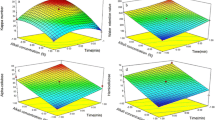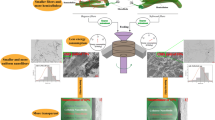Abstract
Cellulose nanofibres (CNFs) are attractive as a material because they can be produced on a large scale, they are renewable, biodegradable and have a wide range of applications. The high-speed blender is an efficient, simple mechanical technique for producing CNF from agricultural waste such as bagasse. The highly hydrophilic nature of CNF restricts its applicability for use in non-aqueous environments, such as those required for preparing composites and for filter applications. This research studied the relationship between blending time in a high-speed blender and the nanofibrillation process with acetylation as a pre-treatment, to develop a new method for creating high quality CNF. Non-acetylated and acetylated CNF was generated using blending times of 5–60 min, and their physical and chemical properties were compared. Fibrillation occurred quickly initially, and increased with increasing blending time although the aspect ratio decreased from 72 to 56 which was measured using a rheological approach while SEM was used to measure the decrease in diameter. Fibre cutting mechanisms were dominant. Acetylation as a pretreatment reduced energy consumption, improving CNF properties using shorter blending times. Apart from higher hydrophobicity, acetylated CNF had higher thermal stability and higher crystallinity and dispersed well in acetone. The combination of acetylation as a pre-treatment coupled with the simple high speed blender technique, has significant advantages for producing high quality CNF, which is less hydrophilic, and was produced with lower energy consumption.
Graphical abstract











Similar content being viewed by others
References
Abe K, Yano H (2009) Comparison of the characteristics of cellulose microfibril aggregates of wood, rice straw and potato tuber. Cellulose 16:1017–1023
Abraham E, Deepa B, Pothan L, Jacob M, Thomas S, Cvelbar U, Anandjiwala R (2011) Extraction of nanocellulose fibrils from lignocellulosic fibres: a novel approach. Carbohydr Polym 86:1468–1475
Andresen M, Johansson L-S, Tanem BS, Stenius P (2006) Properties and characterization of hydrophobized microfibrillated cellulose. Cellulose 13:665–677
Arbelaiz A, Fernandez B, Ramos J, Mondragon I (2006) Thermal and crystallization studies of short flax fibre reinforced polypropylene matrix composites: effect of treatments. Thermochim Acta 440:111–121
Ashori A, Babaee M, Jonoobi M, Hamzeh Y (2014) Solvent-free acetylation of cellulose nanofibers for improving compatibility and dispersion. Carbohydr Polym 102:369–375
Boufi S, Chaker A (2016) Easy production of cellulose nanofibrils from corn stalk by a conventional high speed blender. Ind Crop Prod 93:39–47
Boufi S, Gandini A (2015) Triticale crop residue: a cheap material for high performance nanofibrillated cellulose. RSC Adv 5:3141–3151
Božič M, Vivod V, Kavčič S, Leitgeb M, Kokol V (2015) New findings about the lipase acetylation of nanofibrillated cellulose using acetic anhydride as acyl donor. Carbohydr Polym 125:340–351
Brinchi L, Cotana F, Fortunati E, Kenny J (2013) Production of nanocrystalline cellulose from lignocellulosic biomass: technology and applications. Carbohydr Polym 94:154–169
Brown ME (2001) Introduction to thermal analysis: techniques and applications, vol 1. Springer, Pretoria
Cerqueira DA, Meireles CdS (2007) Optimization of sugarcane bagasse cellulose acetylation. Carbohydr Polym 69:579–582
Chaker A, Mutjé P, Vilar MR, Boufi S (2014) Agriculture crop residues as a source for the production of nanofibrillated cellulose with low energy demand. Cellulose 21:4247–4259
da Cruz SF, Pasquini D, Cerqueira DA, Prado VdS, de Assunção RMN (2000) Water flux through cellulose triacetate films produced from heterogeneous acetylation of sugar cane bagasse. J Membr Sci 177:225–231
De France KJ, Hoare T, Cranston ED (2017) Review of hydrogels and aerogels containing nanocellulose. Chem Mater 29:4609–4631
Deepa B et al (2015) Utilization of various lignocellulosic biomass for the production of nanocellulose: a comparative study. Cellulose 22:1075–1090
Derakhshandeh B, Kerekes R, Hatzikiriakos S, Bennington C (2011) Rheology of pulp fibre suspensions: a critical review. Chem Eng Sci 66:3460–3470
Duran N, Lemes AP, Duran M, Freer J, Baeza J (2011) A minireview of cellulose nanocrystals and its potential integration as co-product in bioethanol production. J Chil Chem Soc 56:672–677
Ellison CJ, Phatak A, Giles DW, Macosko CW, Bates FS (2007) Melt blown nanofibers: fiber diameter distributions and onset of fiber breakup. Polymer 48:3306–3316
French AD (2014) Idealized powder diffraction patterns for cellulose polymorphs. Cellulose 21:885–896
Goh KY, Ching YC, Chuah CH, Abdullah LC, Liou N-S (2016) Individualization of microfibrillated celluloses from oil palm empty fruit bunch: comparative studies between acid hydrolysis and ammonium persulfate oxidation. Cellulose 23:379–390
Goussé C, Chanzy H, Cerrada M, Fleury E (2004) Surface silylation of cellulose microfibrils: preparation and rheological properties. Polymer 45:1569–1575
Ho TTT, Abe K, Zimmermann T, Yano H (2015) Nanofibrillation of pulp fibers by twin-screw extrusion. Cellulose 22:421–433
Hu F, Lin N, Chang PR, Huang J (2015) Reinforcement and nucleation of acetylated cellulose nanocrystals in foamed polyester composites. Carbohydr Polym 129:208–215
Ibbett R, Gaddipati S, Hill S, Tucker G (2013) Structural reorganisation of cellulose fibrils in hydrothermally deconstructed lignocellulosic biomass and relationships with enzyme digestibility. Biotechnol Biofuel 6:33
Izadyar S, Rahimi M (2007) Use of beech wood sawdust for adsorption of textile dyes. Pak J Biol Sci 10:287–293
Jonoobi M, Harun J, Mathew AP, Hussein MZB, Oksman K (2010) Preparation of cellulose nanofibers with hydrophobic surface characteristics. Cellulose 17:299–307
Kargarzadeh H, Ahmad I, Abdullah I, Dufresne A, Zainudin SY, Sheltami RM (2012) Effects of hydrolysis conditions on the morphology, crystallinity, and thermal stability of cellulose nanocrystals extracted from kenaf bast fibers. Cellulose 19:855–866
Kim D-Y, Nishiyama Y, Kuga S (2002) Surface acetylation of bacterial cellulose. Cellulose 9:361–367
Kontturi KS et al (2017) Noncovalent surface modification of cellulose nanopapers by adsorption of polymers from aprotic solvents. Langmuir 33:5707–5712
Li J et al (2012) Homogeneous isolation of nanocellulose from sugarcane bagasse by high pressure homogenization. Carbohydr Polym 90:1609–1613
Li Q, Raj P, Husain FA, Varanasi S, Rainey T, Garnier G, Batchelor W (2015) Engineering cellulose nanofibre suspensions to control filtration resistance and sheet permeability. Cellulose 23:391–402
Li Q, Raj P, Husain FA, Varanasi S, Rainey T, Garnier G, Batchelor W (2016) Engineering cellulose nanofibre suspensions to control filtration resistance and sheet permeability. Cellulose 23:391–402
Liu C-F, Ren J-L, Xu F, Liu J-J, Sun J-X, Sun R-C (2006) Isolation and characterization of cellulose obtained from ultrasonic irradiated sugarcane bagasse. J Agric Food Chem 54:5742–5748
Maiti S, Jayaramudu J, Das K, Reddy SM, Sadiku R, Ray SS, Liu D (2013) Preparation and characterization of nano-cellulose with new shape from different precursor. Carbohydr Polym 98:562–567
Mashkour M, Kimura T, Kimura F, Mashkour M, Tajvidi M (2013) Tunable self-assembly of cellulose nanowhiskers and polyvinyl alcohol chains induced by surface tension torque. Biomacromolecules 15:60–65
Matsuoka S, Kawamoto H, Saka S (2014) What is active cellulose in pyrolysis? An approach based on reactivity of cellulose reducing end. J Anal Appl Pyrol 106:138–146
Menon D, Anoop Anand K, Anitha V, Nair S (2010) Hydroxyapatite-reinforced polyamide 6, 6 nanocomposites through melt compounding. Int J Polym Mater 59:498–509
Miwa M, Nakajima A, Fujishima A, Hashimoto K, Watanabe T (2000) Effects of the surface roughness on sliding angles of water droplets on superhydrophobic surfaces. Langmuir 16:5754–5760
Mwaikambo LY, Ansell MP (2002) Chemical modification of hemp, sisal, jute, and kapok fibers by alkalization. J Appl Polym Sci 84:2222–2234
Parija S, Nayak SK, Jena S (2007) Linear low density polyethylene/clay nanocomposites: influence of MAH-g-PE as compatibilizer loading on the physico-mechanical properties and crystallization characteristics. Polym-Plast Technol 46:183–189
Park S, Baker JO, Himmel ME, Parilla PA, Johnson DKJBfB (2010) Cellulose crystallinity index: measurement techniques and their impact on interpreting cellulase performance. Biotechnnol Biofuels 3:10
Peng Y, Gardner DJ, Han Y, Kiziltas A, Cai Z, Tshabalala MA (2013) Influence of drying method on the material properties of nanocellulose I: thermostability and crystallinity. Cellulose 20:2379–2392
Petroudy SRD, Syverud K, Chinga-Carrasco G, Ghasemain A, Resalati H (2014) Effects of bagasse microfibrillated cellulose and cationic polyacrylamide on key properties of bagasse paper. Carbohydr Polym 99:311–318
Rahimi M, Behrooz R (2011) Effect of cellulose characteristic and hydrolyze conditions on morphology and size of nanocrystal cellulose extracted from wheat straw. Int J Polym Mater 60:529–541
Rainey TJ, Doherty WO, Martinez DM, Brown RJ, Dickson A (2010) The effect of flocculants on the filtration of bagasse pulp pads. Tappi J 5:7–14
Rainey TJ, Doherty WO, Martinez DM, Brown RJ, Kelson NA (2011) Pressure filtration of Australian bagasse pulp. Transp Porous Med 86:737–751
Rambabu N, Panthapulakkal S, Sain M, Dalai A (2016) Production of nanocellulose fibers from pinecone biomass: evaluation and optimization of chemical and mechanical treatment conditions on mechanical properties of nanocellulose films. Ind Crop Prod 83:746–754
Segal L, Creely J, Martin A, Conrad C (1959) An empirical method for estimating the degree of crystallinity of native cellulose using the X-ray diffractometer. Text Res J 29:786–794
Shen W, Filonanko Y, Truong Y, Parker I, Brack N, Pigram P, Liesegang J (2000) Contact angle measurement and surface energetics of sized and unsized paper. Colloid Surf A 173:117–126
Siró I, Plackett D (2010) Microfibrillated cellulose and new nanocomposite materials: a review. Cellulose 17:459–494
Spence KL, Venditti RA, Rojas OJ, Habibi Y, Pawlak JJ (2011) A comparative study of energy consumption and physical properties of microfibrillated cellulose produced by different processing methods. Cellulose 18:1097–1111
Sun R, Fang J, Tomkinson J, Jones G (1999) Acetylation of wheat straw hemicelluloses in N,N-dimethylacetamide/LiCl solvent system. Ind Crop Prod 10:209–218
Sun J, Sun X, Zhao H, Sun R (2004) Isolation and characterization of cellulose from sugarcane bagasse. Polym Degrad Stab 84:331–339
Trache D, Hussin MH, Haafiz MM, Thakur VK (2017) Recent progress in cellulose nanocrystals: sources and production. Nanoscale 9:1763–1786
Uetani K, Yano H (2010) Nanofibrillation of wood pulp using a high-speed blender. Biomacromolecules 12:348–353
Varanasi S, Batchelor WJ (2013) Rapid preparation of cellulose nanofibre sheet. Cellulose 20:211–215
Varanasi S, He R, Batchelor W (2013) Estimation of cellulose nanofibre aspect ratio from measurements of fibre suspension gel point. Cellulose 20:1885–1896
Xie H, King A, Kilpelainen I, Granstrom M, Argyropoulos DS (2007) Thorough chemical modification of wood-based lignocellulosic materials in ionic liquids. Biomacromol 8:3740–3748
Yeganeh F, Behrooz R, Rahimi M (2017) The effect of sulfuric acid and maleic acid on characteristics of nano-cellulose produced from waste office paper. Int J Nano Dimens 8:206–215
Zhang L, Batchelor W, Varanasi S, Tsuzuki T, Wang X (2012) Effect of cellulose nanofiber dimensions on sheet forming through filtration. Cellulose 19:561–574
Zhang S, Sun G, He Y, Fu R, Gu Y, Chen S (2017) Preparation, characterization, and electrochromic properties of nanocellulose-based polyaniline. Nanocompos Films ACS Appl Mater Interfaces 9:16426–16434
Acknowledgments
The authors acknowledge the financial contribution of a PhD scholarship from the QUT School of Chemistry, Physics and Mechanical Engineering and the support of the QUT Central Analytical Research Facility (CARF) at Queensland University of Technology for offering laboratories and equipment for our research.
Author information
Authors and Affiliations
Corresponding author
Additional information
Publisher's Note
Springer Nature remains neutral with regard to jurisdictional claims in published maps and institutional affiliations.
Rights and permissions
About this article
Cite this article
Rahimi Kord Sofla, M., Batchelor, W., Kosinkova, J. et al. Cellulose nanofibres from bagasse using a high speed blender and acetylation as a pretreatment. Cellulose 26, 4799–4814 (2019). https://doi.org/10.1007/s10570-019-02441-w
Received:
Accepted:
Published:
Issue Date:
DOI: https://doi.org/10.1007/s10570-019-02441-w




